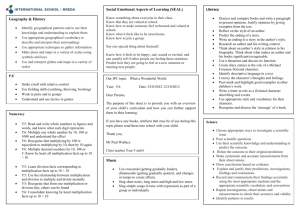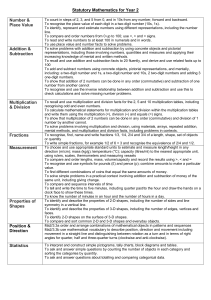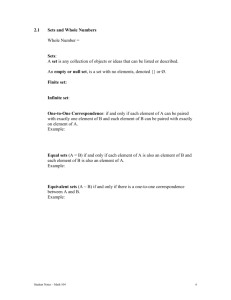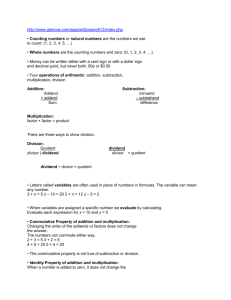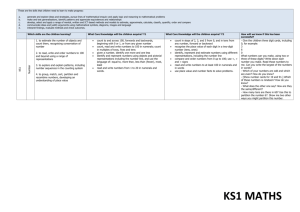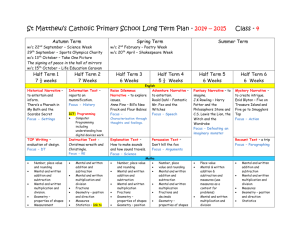"Autumn Long term planning"
advertisement
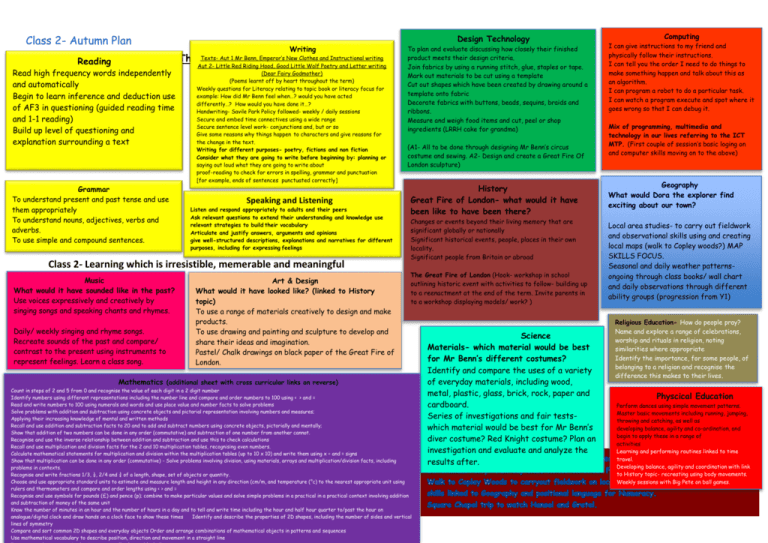
Class 2- Autumn Plan Class 2 Term: Autumn Reading Writing Texts- Aut 1 MrDoor/ Benn, Emperor’s New Clothes and Instructional writing Main - Through the Time Travel Read high frequency words independently and automatically Begin to learn inference and deduction use of AF3 in questioning (guided reading time and 1-1 reading) Build up level of questioning and explanation surrounding a text Grammar To understand present and past tense and use them appropriately To understand nouns, adjectives, verbs and adverbs. To use simple and compound sentences. Aut 2- Little Red Riding Hood, Good Little Wolf Poetry and Letter writing (Dear Fairy Godmother) (Poems learnt off by heart throughout the term) Weekly questions for Literacy relating to topic book or literacy focus for example: How did Mr Benn feel when…? would you have acted differently…? How would you have done it…? Handwriting- Savile Park Policy followed- weekly / daily sessions Secure and embed time connectives using a wide range Secure sentence level work- conjunctions and, but or so Give some reasons why things happen to characters and give reasons for the change in the text. Writing for different purposes- poetry, fictions and non fiction Consider what they are going to write before beginning by: planning or saying out loud what they are going to write about proof-reading to check for errors in spelling, grammar and punctuation [for example, ends of sentences punctuated correctly] Speaking and Listening Listen and respond appropriately to adults and their peers Ask relevant questions to extend their understanding and knowledge use relevant strategies to build their vocabulary Articulate and justify answers, arguments and opinions give well-structured descriptions, explanations and narratives for different purposes, including for expressing feelings Class 2- Learning which is irresistible, memerable and meaningful Music What would it have sounded like in the past? Use voices expressively and creatively by singing songs and speaking chants and rhymes. Daily/ weekly singing and rhyme songs. Recreate sounds of the past and compare/ contrast to the present using instruments to represent feelings. Learn a class song. Art & Design What would it have looked like? (linked to History topic) To use a range of materials creatively to design and make products. To use drawing and painting and sculpture to develop and share their ideas and imagination. Pastel/ Chalk drawings on black paper of the Great Fire of London. Design Technology To plan and evaluate discussing how closely their finished product meets their design criteria. Join fabrics by using a running stitch, glue, staples or tape. Mark out materials to be cut using a template Cut out shapes which have been created by drawing around a template onto fabric Decorate fabrics with buttons, beads, sequins, braids and ribbons. Measure and weigh food items and cut, peel or shop ingredients (LRRH cake for grandma) (A1- All to be done through designing Mr Benn’s circus costume and sewing. A2- Design and create a Great Fire Of London sculpture) History Great Fire of London- what would it have been like to have been there? Changes or events beyond their living memory that are significant globally or nationally Significant historical events, people, places in their own locality. Significant people from Britain or abroad The Great Fire of London (Hook- workshop in school outlining historic event with activities to follow- building up to a reenactment at the end of the term. Invite parents in to a workshop displaying models/ work? ) Mathematics (additional sheet with cross curricular links on reverse) Count in steps of 2 and 5 from 0 and recognise the value of each digit in a 2 digit number Identify numbers using different representations including the number line and compare and order numbers to 100 using < > and = Read and write numbers to 100 using numerals and words and use place value and number facts to solve problems Solve problems with addition and subtraction using concrete objects and pictorial representation involving numbers and measures; Applying their increasing knowledge of mental and written methods Recall and use addition and subtraction facts to 20 and to add and subtract numbers using concrete objects, pictorially and mentally; Show that addition of two numbers can be done in any order (commutative) and subtraction of one number from another cannot. Recognise and use the inverse relationship between addition and subtraction and use this to check calculations Recall and use multiplication and division facts for the 2 and 10 multiplication tables, recognising even numbers. Calculate mathematical statements for multiplication and division within the multiplication tables (up to 10 x 10) and write them using x ÷ and = signs Show that multiplication can be done in any order (commutative) - Solve problems involving division, using materials, arrays and multiplication/division facts, including problems in contexts. Recognise and write fractions 1/3, ¼, 2/4 and ¾ of a length, shape, set of objects or quantity. Choose and use appropriate standard units to estimate and measure length and height in any direction (cm/m, and temperature (°c) to the nearest appropriate unit using rulers and thermometers and compare and order lengths using < > and = Recognise and use symbols for pounds (£) and pence (p); combine to make particular values and solve simple problems in a practical in a practical context involving addition and subtraction of money of the same unit Know the number of minutes in an hour and the number of hours in a day and to tell and write time including the hour and half hour quarter to/past the hour on analogue/digital clock and draw hands on a clock face to show these times Identify and describe the properties of 2D shapes, including the number of sides and vertical lines of symmetry Compare and sort common 2D shapes and everyday objects Order and arrange combinations of mathematical objects in patterns and sequences Use mathematical vocabulary to describe position, direction and movement in a straight line Science Materials- which material would be best for Mr Benn’s different costumes? Identify and compare the uses of a variety of everyday materials, including wood, metal, plastic, glass, brick, rock, paper and cardboard. Series of investigations and fair testswhich material would be best for Mr Benn’s diver costume? Red Knight costume? Plan an investigation and evaluate and analyze the results after. Computing I can give instructions to my friend and physically follow their instructions. I can tell you the order I need to do things to make something happen and talk about this as an algorithm. I can program a robot to do a particular task. I can watch a program execute and spot where it goes wrong so that I can debug it. Mix of programming, multimedia and technology in our lives referring to the ICT MTP. (First couple of session’s basic loging on and computer skills moving on to the above) Geography What would Dora the explorer find exciting about our town? Local area studies- to carry out fieldwork and observational skills using and creating local maps (walk to Copley woods?) MAP SKILLS FOCUS. Seasonal and daily weather patternsongoing through class books/ wall chart and daily observations through different ability groups (progression from Y1) Religious Education- How do people pray? Name and explore a range of celebrations, worship and rituals in religion, noting similarities where appropriate Identify the importance, for some people, of belonging to a religion and recognise the difference this makes to their lives. Physcical Education Perform dances using simple movement patterns. Master basic movements including running, jumping, throwing and catching, as well as developing balance, agility and co-ordination, and begin to apply these in a range of activities Learning and performing routines linked to time travel. Developing balance, agility and coordination with link to History topic- recreating using body movements. Weekly sessions with Big Pete on ball games.


